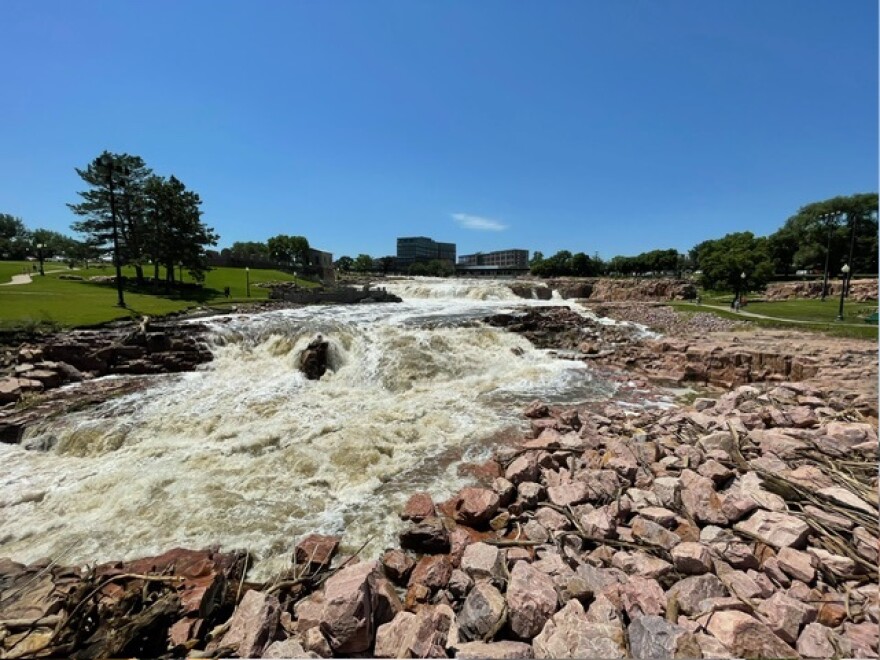State leaders say the Big Sioux River has reached its highest point, but they still expect flooding issues to persist in southeast South Dakota in the coming days.
Gov. Kristi Noem said in a press conference Monday the Big Sioux crested overnight at just under 45 feet. That surpasses the previous record by seven feet.
Flooding prompted a voluntary evacuation alert in Dakota Dunes. Noem said several homes in the community were destroyed. North Sioux City also experienced widespread flooding.
“One thing I’m going to ask everybody is to continue to stay away, if they can, to evacuate their homes, if they can, and to stay off our roadways. Don’t come and look at the floodwaters at this point and time," Noem said.
A section of Interstate 29 in the southeastern corner of the state remained closed Monday due to flooding. The Department of Transportation said crews built a berm on the interstate near North Sioux City to mitigate flooding.
Interstate Closure Update (Monday, June 24, 2024 - 7:15 a.m.).
— SDDOT (@SouthDakotaDOT) June 24, 2024
The Interstate 29 closure was extended between exits 2 and 26 to aid in southbound traffic flow to and through the designated detour route.
Find detour maps: https://t.co/YZiEpXSybM or https://t.co/tn5Y8DUVlQ pic.twitter.com/FbsTjGLrCe
Noem said the Big Sioux crested sooner than expected, making the joint project more challenging.
"We expected we had overnight, possibly, to build a levee over the interstate, and then within in an hour that had changed dramatically," Noem said. "We also had to build that levee within a few hours, but yet the city and the Department of Transportation got it done.”
Despite hopes I-29 would reopen by Monday night, officials said the interstate would likely not reopen until Tuesday. Several other highways and roads across the region remained closed Monday due to flooding, according to the state's 511 road conditions map.
Other aspects of infrastructure are also being impacted. Noem said a railroad bridge in North Sioux City was washed out by floodwaters.

While the Big Sioux crested higher and faster than expected, Noem said the outlook is improving for other rivers in the region. She said the James River will crest near Yankton Wednesday at 24.7 feet. The Vermillion River is expected to crest at record levels near Wakonda like on Wednesday, which is also later than originally thought. This gives crews more time to prepare and reinforce levees in the region.
The delayed timeline also eases pressure on the Missouri River, which each of these rivers feeds into. Department of Agriculture and Natural Resources geologist Tim Cowman said officials do not expect the Missouri River to rise much in the coming days.
"Our feeling is that the Big Sioux will obviously be past its crest and will have dropped enough that we'll see drops in the Missouri by the times the pulses from the James and Vermillion get here," Cowman said.
Flood control efforts are also boosted by the forecast. The National Weather Service is forecasting warm, dry conditions in the region through the middle of the week.
The flooding comes after several days of heavy rainfall late last week. A large swath of southeast South Dakota saw around six inches of rain between Thursday and Saturday, with some areas seeing much more. Officials said the community of Canton received around 18 inches over that timeframe.
The National Weather Service said both Sioux Falls and Mitchell set records for wettest two-day period on June 20 and June 21. Mitchell received 7.7 inches of rain, while Sioux Falls' official reading was 6.49 inches.

Sioux Falls city officials say the city's wastewater plant ran out of excess storage over the weekend, forcing the facility to discharge untreated wastewater into the Big Sioux River. Mayor Paul TenHaken asked residents to reduce any activities that put extra water into the wastewater system, but that request was lifted Sunday evening as the system recovered.
Noem on Saturday signed an emergency declaration for storms and flooding which sets into motion the process for requesting disaster funding from FEMA.
Rep. Dusty Johnson said at Monday's press conference he and South Dakota's congressional delegation will back Noem's request for federal assistance.
"We don't know exactly what decision the federal administration will make in regards to individual assistance," Johnson said. "Although I can tell you, having seen some of the damage, having a sense of how high these waters are, I would be surprised if there would not be a robust federal assistance, when we talk about recover."
Noem's order also included a “no boating declaration” which is effective on the following bodies of water:
- Lake Alvin in Lincoln County
- Lake Henry in Bon Homme County
- Marindahl Lake in Yankton County
- Menno Lake in Hutchinson County
- Swan Lake in Turner County
- Wall Lake in Minnehaha County
- Lake Vermillion in McCook County
- McCook Lake in McCook County
Watch Noem's full press briefing below


